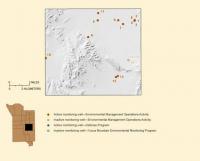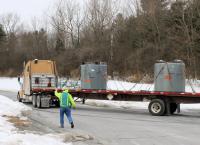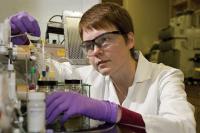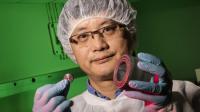-
Nuclear forensics summer program trains students for a future in nuclear security
A sure sign of summer is the return of interns to the Lawrence Livermore campus. Students interact with premier researchers and access equipment and facilities not available anywhere else, while scientists lay groundwork for advancing their fields. LLNL runs an eight-week summer internship for students interested in nuclear science and its range of specialties — nuclear forensics, environmental radiochemistry, nuclear physics, and beyond. Together, these disciplines support the laboratory’s nuclear security mission through analysis of nuclear processes and properties.
-
-
Improving detection of concealed nuclear materials

Researchers have demonstrated proof of concept for a novel low-energy nuclear reaction imaging technique designed to detect the presence of “special nuclear materials” — weapons-grade uranium and plutonium — in cargo containers arriving at U.S. ports. The method relies on a combination of neutrons and high-energy photons to detect shielded radioactive materials inside the containers.
-
-
Helping inspectors locate and identify underground nuclear tests
Through experiments and computer models of gas releases, scientists have simulated signatures of gases from underground nuclear explosions (UNEs) that may be carried by winds far from the point of detonation. The work will help international inspectors locate and identify a clandestine UNE site within a 1,000 square kilometer search area during an on-site inspection that could be carried out under the Comprehensive Nuclear Test Ban Treaty.
-
-
“Acceptable risk” is a better way to think about radiation exposure in Fukushima
Five years after the Fukushima disaster, many of these people remain refugees, unable to return home for fear of radiation exposure. As the radioactivity cleanup continues, people are coming to an uncomfortable realization: although cleanup can reduce the level of radioactive contamination, the environmental radiation dose levels within the prefecture will remain elevated for many generations before they finally reach the very low levels that existed prior to the accident. So, when will it be safe for people to return to their homes and to normal life in the Fukushima Prefecture? With regard to radiation exposure, “safe” really means an “acceptable level of risk,” and not everyone agrees on what is acceptable. Providing people with this risk characterization information, at the very least, is within the power of all radiation regulatory agencies, even if achieving complete cleanup of the environment is beyond their reach. This public information void about radiation risks needs to be filled. People can make their own decisions once they’re empowered with credible and intelligible risk information.
-
-
Remote detection of radioactive materials
National security experts believe terrorists continue to be interested in such devices for terror plots. Now researchers have proposed a new technique remotely to detect the radioactive materials in dirty bombs or other sources. It is the increased ion density that the researchers aim to detect with their new method. They calculate that a low-power laser aimed near the radioactive material could free electrons from the oxygen ions.
-
-
Secretive Area 6 used to test aerial radiation detection equipment

Top-secret Nevada site – even more secret than neighboring Area 51 — is used by Pentagon, DHS to test drones equipped with sensors to detect radioactive material which could be used in dirty bombs. The site, located in Yucca Flat, was once used for nuclear testing.
-
-
Truck carrying toxic nuclear materials stolen in Mexico

Five Mexican states have been placed on a state of alert after a truck carrying a container of dangerous radioactive material was stolen, the Mexican Interior Ministry has said. The material could cause permanent or serious injury to a person who is in contact with it for a short time, and is fatal when exposure lasts for more than a few hours.
-
-
Air data can be used to reconstruct radiological releases
New research demonstrates that experts can use data from air sampling technology to not only detect radiological releases, but to accurately quantify the magnitude and source of the release. This has applications for nuclear plant safety, as well as national security and nuclear nonproliferation monitoring.
-
-
U.S. testing radiation therapy developed in Israel
The United States will likely begin to stock anti-radiation therapy from Pluristem Therapeutics Inc., an Israeli biotech company. The company says that the therapy can also cure nearly all people exposed to the radiation effects of nuclear weapons, “dirty” bombs, or nuclear power plants.
-
-
Predicting clay swelling for better nuclear waste disposal
Bentonite clay is planned to be used as a key barrier in the deep geological disposal of high-level nuclear waste. To ensure the safety of disposal, it is crucial to understand and predict the swelling behavior of bentonite clay. The swelling property, however, is regulated by multiple structural and environmental factors. A new model simulates the atomic-level interactions among the components of clay-water system, reproducing the swelling trends and swelling pressures measured by experiments with good accuracy.
-
-
ISIS may get its hands on “highly dangerous” nuclear material stolen in Iraq
Iraqi security agencies are searching for “highly dangerous” radioactive material stolen last year. Experts are worried that the material could fall into the hands of ISIS. The material – Ir-192 — is designated a Category 2 radioactive by the IAEA, and it could be used to build a “dirty bomb,” which combines nuclear material with conventional explosives to contaminate an area with radiation.
-
-
Specialized ORNL team uses nuclear forensics to solve mysteries, safeguard materials

From the Manhattan Project in the 1940s to the High Flux Isotope Reactor’s 50th anniversary and its selection as an American Nuclear Society Nuclear Historic Landmark, the Department of Energy’s Oak Ridge National Laboratory (ORNL) has been the preeminent destination for nuclear R&D. A group of nuclear detectives at ORNL) takes on tough challenges, from detecting illicit uranium using isotopic “fingerprints” to investigating presidential assassination conspiracies.
-
-
Symetrica inaugurates Radioactive Threat Verification Solutions Hub
Southampton, U.K.-based Symetrica has inaugurated the company’s new Radioactive Threat Verification (RTV) Solutions Hub. The company says that the new facility will improve the company’s ability to support the global security community – including the U.K.’s Home Office and Border Force, the U.S. Department of Homeland Security, and other border protection agencies.
-
-
New X-ray method could detect nuclear materials

Inspectors need tools to help find nuclear materials hidden behind thick shielding or smuggled inside any of the 100 million-plus cargo containers shipped around the world each year. Uranium is perhaps the easiest nuclear material to obtain and hide. Physicists have demonstrated that their unconventional laser-based X-ray machine could provide a new defense against nuclear terrorism. The scientists used the laser-driven X-ray source to produce an image of a uranium disk no bigger than a stack of three nickels and hidden between 3-inch steel panels.
-
-
Demonstrating technologies for disaster response
Radiological incidents such as Chernobyl and Fukushima illustrate the need for effective coordination of federal, state, and local agencies in response efforts. Earlier this year, the Department of Homeland Security (DHS) Science and Technology Directorate’s (S&T) National Urban Security Technology Laboratory (NUSTL) and the Environmental Protection Agency (EPA) demonstrated new technology developments at the Columbus, Ohio, Battelle Memorial Institute facility that will enable more effective radiological decontamination.
-
- All
- Regional
- Water
- Biometrics
- Borders/Immig
- Business
- Cybersecurity
- Detection
- Disasters
- Government
- Infrastructure
- International
- Public health
- Public Safety
- Communication interoperabillity
- Emergency services
- Emergency medical services
- Fire
- First response
- IEDs
- Law Enforcement
- Law Enforcement Technology
- Military technology
- Nonlethal weapons
- Nuclear weapons
- Personal protection equipment
- Police
- Notification /alert systems
- Situational awareness
- Weapons systems
- Sci-Tech
- Sector Reports
- Surveillance
- Transportation
Advertising & Marketing: advertise@newswirepubs.com
Editorial: editor@newswirepubs.com
General: info@newswirepubs.com
2010-2011 © News Wire Publications, LLC News Wire Publications, LLC
220 Old Country Road | Suite 200 | Mineola | New York | 11501
Permissions and Policies
Editorial: editor@newswirepubs.com
General: info@newswirepubs.com
2010-2011 © News Wire Publications, LLC News Wire Publications, LLC
220 Old Country Road | Suite 200 | Mineola | New York | 11501
Permissions and Policies
